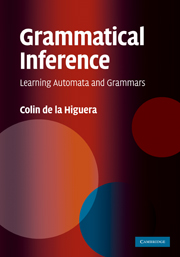Book contents
- Frontmatter
- Contents
- Preface
- Acknowledgements
- 1 Introduction
- 2 The data and some applications
- Part I The Tools
- Part II What Does Learning a Language Mean?
- Part III Learning Algorithms and Techniques
- 11 Text learners
- 12 Informed learners
- 13 Learning with queries
- 14 Artificial intelligence techniques
- 15 Learning context-free grammars
- 16 Learning probabilistic finite automata
- 17 Estimating the probabilities
- 18 Learning transducers
- 19 A very small conclusion
- References
- Index
15 - Learning context-free grammars
from Part III - Learning Algorithms and Techniques
Published online by Cambridge University Press: 05 July 2014
- Frontmatter
- Contents
- Preface
- Acknowledgements
- 1 Introduction
- 2 The data and some applications
- Part I The Tools
- Part II What Does Learning a Language Mean?
- Part III Learning Algorithms and Techniques
- 11 Text learners
- 12 Informed learners
- 13 Learning with queries
- 14 Artificial intelligence techniques
- 15 Learning context-free grammars
- 16 Learning probabilistic finite automata
- 17 Estimating the probabilities
- 18 Learning transducers
- 19 A very small conclusion
- References
- Index
Summary
Too much faith should not be put in the powers of induction, even when aided by intelligent heuristics, to discover the right grammar. After all, stupid people learn to talk, but even the brightest apes do not.
Noam Chomsky, 1963It seems a miracle that young children easily learn the language of any environment into which they were born. The generative approach to grammar, pioneered by Chomsky, argues that this is only explicable if certain deep, universal features of this competence are innate characteristics of the human brain. Biologically speaking, this hypothesis of an inheritable capability to learn any language means that it must somehow be encoded in the DNA of our chromosomes. Should this hypothesis one day be verified, then linguistics would become a branch of biology.
Niels Jerne, Nobel Lecture, 1984Context-free languages correspond to the second ‘easiest’ level of the Chomsky hierarchy. They comprise the languages generated by context-free grammars (see Chapter 4).
All regular languages are context-free but the converse is not true. Among the languages that are context-free but not regular, some ‘typical’ ones are:
• {anbn: n ≥ 0}. This is the classical text book language used to show that automata cannot count in an unrestricted way.
- Type
- Chapter
- Information
- Grammatical InferenceLearning Automata and Grammars, pp. 300 - 328Publisher: Cambridge University PressPrint publication year: 2010



